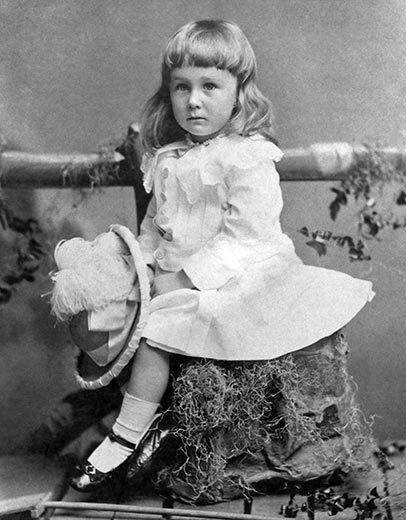Why Nobody Cared When FDR Wore a Dress

Franklin D. Roosevelt, photographed in 1884.
A Smithsonian.com article on gendering trends in clothing, “When Did Girls Start Wearing Pink?,” has me thinking about lots of things–from how I dress my son to how I portray children in my novels. Here’s the article’s answer to why it was perfectly unexceptional for FDR to wear a dress in the above photo:
Social convention of 1884, when FDR was photographed at age 2 1/2, dictated that boys wore dresses until age 6 or 7, also the time of their first haircut. Franklin’s outfit was considered gender-neutral.
The photo gallery that accompanies the article is especially intriguing, showing a number of period photographs as well as boy paper dolls whose wardrobes include pink dresses and lots of frilly lace. Now, why does it weird so many of us out to see a former president in a dress?
“It’s really a story of what happened to neutral clothing,” says Paoletti… For centuries, she says, children wore dainty white dresses up to age 6. “What was once a matter of practicality—you dress your baby in white dresses and diapers; white cotton can be bleached—became a matter of ‘Oh my God, if I dress my baby in the wrong thing, they’ll grow up perverted,’ ” Paoletti says.
Jo Paoletti is the author of the forthcoming Pink and Blue: Telling the Girls From the Boys in America (IU Press). If the Smithsonian article interests you, check out Paoletti’s website, which also includes links to many of the sources she consulted in writing the history. One of her most interesting findings is that the use of pink=girl and blue=boy is relatively recent–in the past, pink was actually viewed as a stronger color more appropriate for boys than “dainty” blue.
As a new parent, I’m becoming increasingly aware of the gendering, not just of clothing, but of toys and toy stores. This Guardian article chronicles two moms’ campaign against the commercial pinkificiation of girls’ lives (Their website is pinkstinks.co.uk). Here’s a bit:
There is a pink globe, specially for girls. Scrabble has been repackaged in pink (the tiles on the front of the box spell FASHION). Monopoly has gone pink, with the dog, thimble and shoe pieces replaced by flip-flops, a handbag and a hairdryer, houses and hotels becoming boutiques and malls, and utilities turned into beauty salons. In at least one major supermarket chain you can now buy slices of bright pink ham, cut into heart shapes and called Fairy Hearts.
It seems to me that this whole thing is a lot worse for girls than boys. In fact, I hadn’t given it much thought until coming across these articles (bad me, I know). It’s true that Liam’s clothes (all of which are hand-me-downs) are sometimes blue and covered in football-wielding bears. But he also has a lot of pretty neutral stuff, like shirts with fishes and frogs.
I wonder, though, if it will be harder to keep things neutral for a future (as yet unconceived, possibly never-to-exist) sister. If we are deliberate enough, might we keep the tide of pink at bay? I am starting to think this is a pretty big deal. Consider this appeal, reported in the Guardian article:
“I am nine years old,” wrote one girl, “and I think PinkStinks is my voice. Girls like me shouldn’t be forced to like pink. Can you think of a good name for girls who don’t want to be girly girls but aren’t tomboys?”
My heart goes out to her. I want to buy her an “I am not a princess” T-shirt and send it to her. But can I do something more? Both of my YA novels feature little sisters who play with dolls and like Dora the Explorer. Perfectly probable, given the state of things in stores as described above. Believability, however, isn’t the only thing that matters. Maybe I need to pay a little more attention to other little sibling possibilites. Maybe I’ll have to work on a character who finds just such a good name for the non-girly girls.




